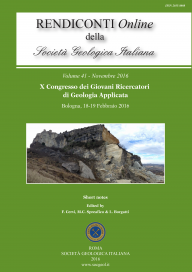
Borehole Heat Exchangers in aquifers: simulation of the grout material impact
Luca Alberti(a), Adriana Angelotti(b), Matteo Antelmi(a) & Ivana La Licata(a)
(a)Dipartimento di Ingegneria Civile Ambientale. Politecnico di Milano, P.zza L. da Vinci 32, 20133 Milano, Italia
(b)Dipartimento di Energia, Politecnico di Milano, via Lambruschini 4, 20156 Milano, Italia
Volume: 41/2016
Pages: 268-271
Abstract
In Ground Source Heat Pump installations the U-shaped pipes are located in boreholes filled with grouts that are enhanced from the thermal conductivity point of view and usually hydraulically impermeable. Here two cases are considered: (1) a numerical finite-difference model of a single U-pipe in a sandy aquifer, implemented using the MT3DMS code, where the grout material surrounding the Borehole Heat Exchanger is not simulated and (2) the same numerical model where, in turn, the presence of the grout is accounted for in a small volume around the Borehole Heat Exchanger, as in real in situ conditions. Simulations were carried out first keeping the heat rate constant, as when simulating a Thermal Response Test, and then maintaining the inlet temperature constant in order to reproduce the yearly operation of the Ground Source Heat Pump system. Then, fitting the numerical ground response with analytical solutions and comparing the two models, the effect of the grout material was assessed in terms of exchanged energy and temperature distribution in the subsoil. Results show that the presence of the grout around the Borehole Heat Exchanger is negligible from the exchanged energy and temperature distribution point of view. Whereas, looking at the Darcy velocities it was noticed that the ones returned by the analytical solutions (that necessarily neglects the presence of the grout) are at least 30% smaller than the velocities implemented in the grouted model. So when comparing the MT3D simulations, or using MT3D for TRT interpretation, the presence of the grout around the BHE can at a first approximation be disregarded in terms of both exchanged energies and temperature distribution in the subsoil. In turn when Darcy velocity, obtained by Thermal Response Test interpretation through analytical solutions (MLS), is used in a numerical model it must be corrected specially for advection-dominated cases.
Keywords
Get Full Text